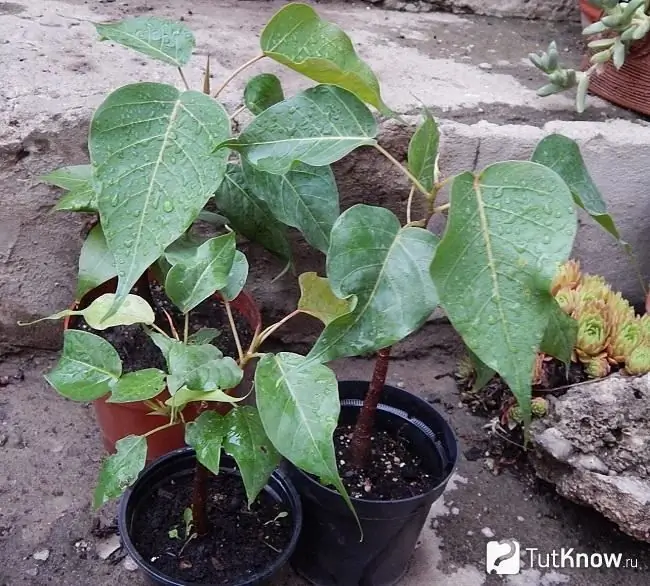Characteristics of the plant, tips for growing sacred ficus at home, how to reproduce, pest and disease control, facts for the curious. The sacred ficus does not have any special requirements for the composition of the soil. It is only important that it is loose and fertile, with an acidity of pH 6–6, 5. You can use a ready-made store-bought composition for ficuses or prepare the substrate yourself, choosing from the following options:
- Sod (rich in nutrients, which includes many mineral trace elements, as well as such a mixture is light and friable) and leafy soil, taken in equal shares with half of river sand, and a little crushed charcoal is added there.
- Leafy land (it should be collected in forest park areas from under deciduous trees, taking a little rotted foliage), sod soil and peat, which are taken in equal proportions.
- Sod substrate, peat and coarse sand in a ratio of 1: 3: 1.
After transplanting, you should not immediately put the plant in a brightly lit place, it is necessary to give the religious ficus a couple of days for adaptation, and watering at this time should not be abundant, the moisture that was carried out during the transplant is enough.
Since the sacred ficus is characterized by an increased growth rate, it should be regularly limited. In this case, it is necessary to shorten too elongated shoots. It is recommended to engage in such an operation before the start of growth activation, when the plant juices are not yet spreading too quickly. However, as the young branches grow, they will need to pinch the tops.
There is another method of shaping the crown of the sacred fig with the necessary outlines. Since the young branches of the plant are distinguished by increased flexibility, when using a wire frame, they are given any contours conceived. Also among florists, the molding of Ficus religiosa trunks is also common - they are also quite flexible and elastic, then they can be woven into a pigtail or plait. But for this, during reproduction, it is necessary to place 3-4 pieces of young Bo trees in one container.
Propagation of sacred ficus by seeds and cuttings

It is easy to get new ficus by sowing seeds or rooting cuttings.
The simplest method of seed propagation is considered when fully ripe syconium or acquired seed material is used. Usually, sowing is carried out in a peat-sandy substrate, pre-moistened. Then the container with the crops is covered with a plastic transparent film and placed in a warm place (temperature about 25 degrees), with sufficiently bright lighting, but without direct sunlight. It is recommended to carry out daily ventilation and if the soil begins to dry out, then it is sprayed from a spray bottle with warm and soft water.
After about 7 days, you can see the first shoots, then the shelter must be removed and the seedlings must be accustomed to indoor conditions. When a pair of real leaves unfold on young sacred ficuses, then a transplant is carried out into a separate pot (diameter about 7 cm), but if you take a container with a diameter of 10 cm, then 3-4 plants can be placed in it. As they grow, transplants and pinching of the tops of the shoots should be carried out.
If you try to root cuttings, then there is information that they sometimes give roots very reluctantly. The workpieces are cut in the spring, they should be 8–10 cm, the cut is dried from milky juice and sprinkled with a root formation stimulator. Landing is carried out in peat-sandy soil. Also, the cuttings are covered with transparent polyethylene. You will need daily ventilation and, if necessary, watering. In 14–20 days, the cuttings take root and are planted.
Diseases and pests of the sacred ficus

With reduced dryness, the plant suffers from scale insects, spider mites or mealybugs. Spraying with insecticides is recommended. If decay of the root system has begun due to waterlogging of the soil, then transplantation into a sterile pot and soil is necessary, followed by treatment with fungicides.
With any change in the regime or the rules of keeping, the religious ficus begins to throw off its foliage. If the direct rays of the sun are constantly shining on the leaves, then it will begin to dry out at the edges and brown spots will appear in the center. With a lack of light, the shoots are strongly stretched, and the size of the leaves becomes smaller.
Facts about the sacred ficus for the curious, photo

It is interesting that the foliage of the sacred ficus has the property of constantly shaking, moving, and due to such continuous movement (even if the weather is calm) rustling is heard. But this is due to the fact that the leaf petiole is rather long, and the leaf plate is too large for it. But in ancient times it was believed that mythical creatures "devas" or "gods" live on the trees, which contribute to the movement of leaves.
Religious ficus has the property of guttation - that is, if the humidity level of the environment increases, then drops of moisture begin to collect on the tips of the leaves, as if the tree begins to "cry".
Pilgrims from all over the world on the branches of sacred ficus trees growing near temples at all times tied colorful ribbons, and the local population at their base put their offerings. They know about the properties of the sacred fig since ancient times, since with its help it was possible to cure up to 50 types of diseases, including: diabetes mellitus and asthma, gastrointestinal diseases, epilepsy and some inflammatory and infectious ailments.






